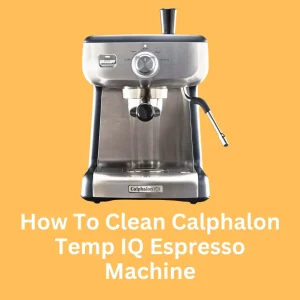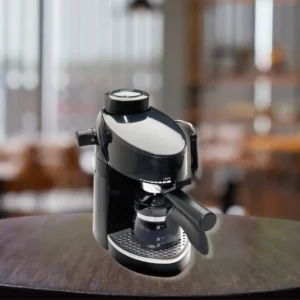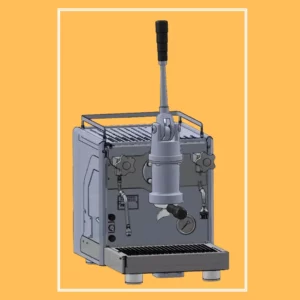Affiliate Disclaimer
As an Amazon Associate, I earn from qualifying purchases. It supports the website. So, Thank you. ❤️
So what do BARs mean on espresso machines? If you’re interested in creating the perfect espresso shot, then you should know exactly what they are.
The BAR is a measurement that many espresso aficionados use to gauge the quality of their coffee. The term “BAR” comes from its role as a gauge in brewing and other industrial applications to measure physical forces.
What Does The Pressure Setting Do In Espresso Machine?
A pressure setting, also known as “Bar Pressure,” is the amount of pressure applied to the espresso machine’s portafilter when you’re making a shot.
The setting is a dial that controls the water flows through the pump espresso machine. Turning it up increases the amount of coffee that is extracted from the coffee grinds. This is important because your espresso machine should not be over-extracted; otherwise, you’ll end up with a bitter cup of coffee instead of a sweet and aromatic one.
A pressure setting is a way that a coffee machine calculates the amount of pressure it needs to use to make coffee. In an espresso machine, it’s most often done by using a spring-loaded mechanism that presses down on a lever.
When you press the lever down, it releases pressure in order to heat up the water. This can affect how much foam you get and how quickly your coffee will brew.
What Do BARs Mean On Espresso Machines?
The espresso machine is an integral part of many households and a must-have appliance for all espresso coffee shops. The first step to understanding espresso is understanding how espresso is made. The process of espresso making requires an amount of pressure. But what do BARs mean on espresso machines?
The pressure on espresso machines is measured in Bars. Elaborately speaking, BARs on espresso machines are used to measure the amount of pressure an espresso machine can produce to brew a perfect cup of coffee.
Barometric pressure, generally known as atmospheric pressure, is measured in BARs. 1 bar is the same as the atmospheric pressure at sea level. If you see an espresso machine of 9 or 11 bars, this particular machine can create pressure equal to 9 or 11 times higher than that of sea-level atmospheric pressure.
The Higher The BAR Pressure Is, The More Flavorful and Robust Your Espresso Will Be.
The bar pressure affects espresso quality because it affects the extraction rate of the coffee. It is a key factor in how fast your coffee will be extracted. The more bar pressure you use, the faster the extraction will occur. The extraction of your coffee will take longer if you apply less pressure.
Bar Pressure also affects espresso quality in other ways too.
First(1st), high bar pressure can squeeze out more water and coffee grounds, which leads to a stronger espresso coffee flavor.
Second(2nd), high pressure can lead to a loss of heat from the coffee grounds, which can cause the espresso to taste bitter or burnt.
How Many Bars Of Pressure For Espresso?
The first thing here is: “It depends on who you ask. Different people have different choices of taste. What’s best for you depends on how strong your coffee tastes, how often you make it, and how much time you have.”
The espresso machine pressure is the amount of pressure put on the coffee beans by the espresso machine. It’s the force of water in the espresso machine that pushes the coffee grounds through the pressurized and filtered water.
If you’re making a single shot of espresso every day, then a 7 or 9 Bar will be fine.
But if you’re using your machine for commercial purposes, like an Italian coffee shop or a cafe in the mall, then a 9 or 15 bar is definitely better.
How do you know when your machine has the right amount of pressure? It’s not easy. Finding what works best for the coffee you use requires a lot of skill and try and error. You’ll have to play around with your machine until you find that sweet spot where it makes really good espresso.
What Does 3.5 Bar Espresso Mean?
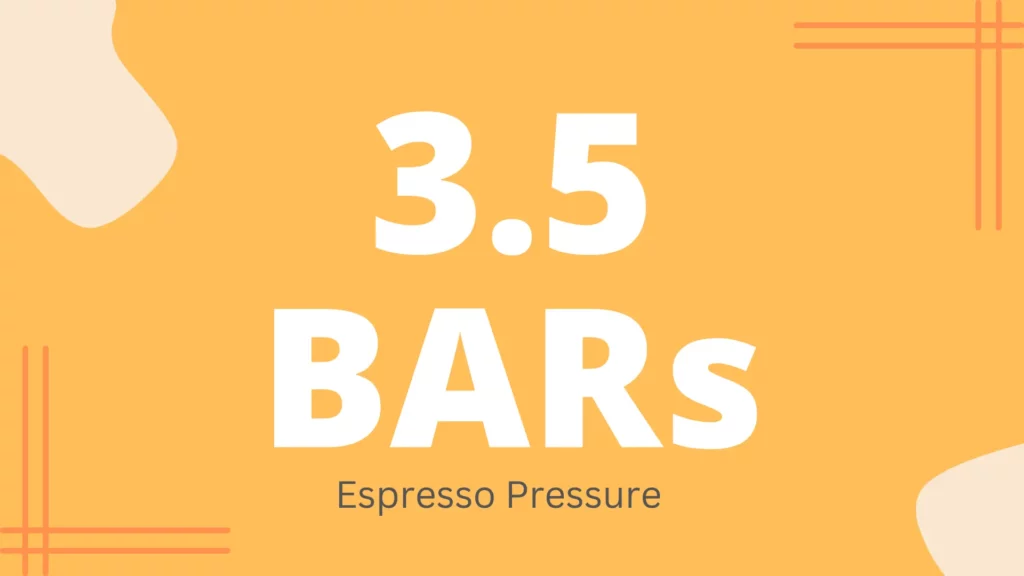
3.5 Bar espresso means that the espresso is being made at a pressure of 3.5 Bars.
It refers to the amount of pressure the coffee maker uses to force water through the coffee grounds. It is one of the lowest amounts of pressure to brew a cup of espresso from semi-automatic pump espresso machine. At this pressure level, the coffee tastes very weak and watery.
Are 3.5 Bars of Pressure Good for Espresso?
You’re probably thinking that a 3.5 bar of pressure is too low to get a good shot of espresso. It is kind of true. It’s not so much that you’ll be able to make a good espresso with it. But if you’re using the right technique and equipment, you can get a decent shot of espresso at 3.5 bars of pressure. If you like to have a lighter taste in your coffee, then 3.5 bars of pressure is good for you.
Why Is Espresso Machine At 4 Bars?
The reason behind it is that it’s simple, easy to use, and requires less time and effort than other models.
The espresso machine at 4 bars is a variation of the classic 3 bar espresso machine. It’s not uncommon to see this style of machine in high-end professional settings, but it is also common at home.
For regular home use, a 4-bar espresso machine will work for you. If you’re making a regular cup of coffee, then 4 bars will get the correct level of pressure. Like 3.5 bar, a 4 bar espresso machine won’t produce as flavorful and rich-tasting coffee, but it gets the job done.
What Does 5 Bar Espresso Mean?
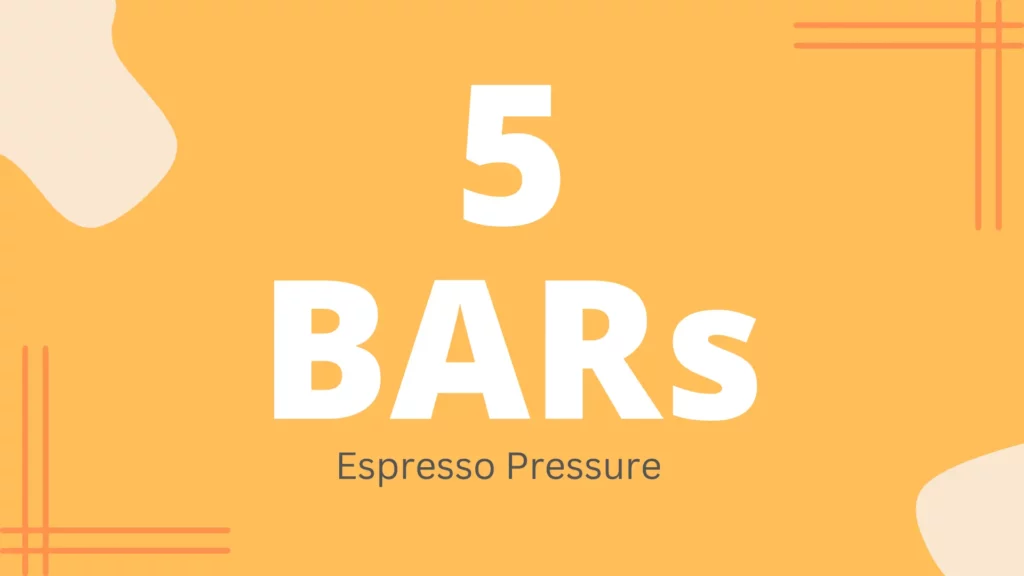
Simply saying, 5-Bar espresso is a measure of pressure and temperature in the espresso extraction process.
5 bar espresso is below the standard for measuring pressure in an espresso machine. It represents the amount of pressure that your espresso machine applies 5 bar to the water in order to extract maximum flavor from ground coffee beans.
The higher the number of bars, to the coffee beans, the more pressure and heat are applied. This means that your cup of espresso will taste richer and more flavorful than a 4-bar espresso.
Are 5 Bars Of Pressure Good For Espresso?
For espresso, there are many different opinions on what is the perfect amount of pressure to use. A 5-bar espresso machine is a high-end coffee maker that produces a more intense espresso. The pressure in the machine is set to 5 bars, which is about twice as much as a typical home espresso machine.
The brewing process must wait until the water has reached the proper temperature. This can be too long for some people, especially if they are in a hurry.
What Does 9 Bar Espresso Mean?

The 9-bar espresso extraction is one of the most popular and common methods of brewing coffee. It involves using about 9 bars of pressure when extracting the coffee, which results in a higher concentration of caffeine.
The 9-bar espresso machine is a very popular coffee maker that is used in restaurants, cafes, and homes. This system was originally developed in Italy as a way to keep track of how much water was used to make an espresso to get a better-tasting espresso.
Are 9 Bars Of Pressure Good For Espresso?
Nine(9) bars of pressure is the sweet spot for most espresso machines, which means that your machine has a good chance of producing an evenly-extracted and delicious cup.
With just the perfect amount of pressure, the greatest espresso makers can produce a fantastic shot. You don’t have to play more than nine bars, in my opinion. If you really wish to step up your game, remember a few things.
Make sure your machine is rated for 9 bars of pressure. Some models are rated for 15,19 or even 20 bars. The higher the number of bars, the more intense the shot will be. But this isn’t necessary for a great espresso. You can have a better-tasting coffee with a machine that can put pressure at 9 bars.
Most coffee machines are at 9 bars and many coffee lovers use to get a shot at 9 bars. Because this is the sweet spot.
What Does 15 Bar Espresso Mean?
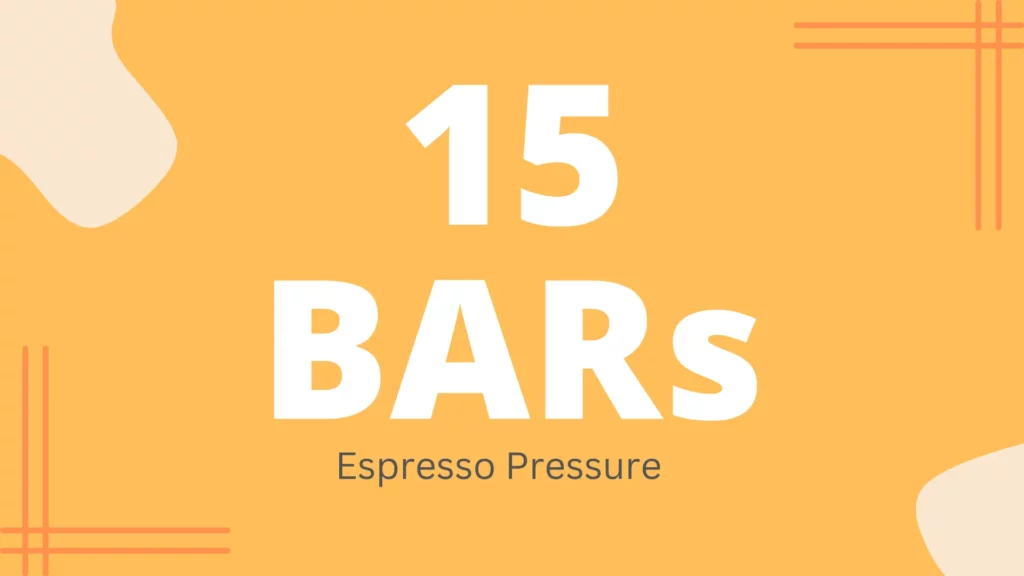
15 Bar means that the espresso has been extracted to the point where the pressure is 15 times stronger than the atmospheric pressure.
A 15-bar espresso is a coffee that has been brewed with one of the highest levels of extraction. Only pump-driven espresso machines can produce this much pressure.
Not many machines have a capability of 15 bar. But it is not rare at all. As people’s tastes have evolved, many people choose to get a higher concentrated taste of coffee and they buy a 15-bar espresso machine.
Are 15 Bars Of Pressure Good For Espresso?
15-bar espresso is stronger than 9 bar, but it also has a different taste. A 15-bar espresso will have a fuller body and richer flavor than a 9-bar. It’s also more acidic and has more caffeine. If you want the strongest cup of coffee possible, then 15 bars is definitely for you.
It just has a different taste and feels than the lower bars. If you like strong coffee, then 15 bars is your perfect pressure choice!
What Does 19 Bar Espresso Mean?
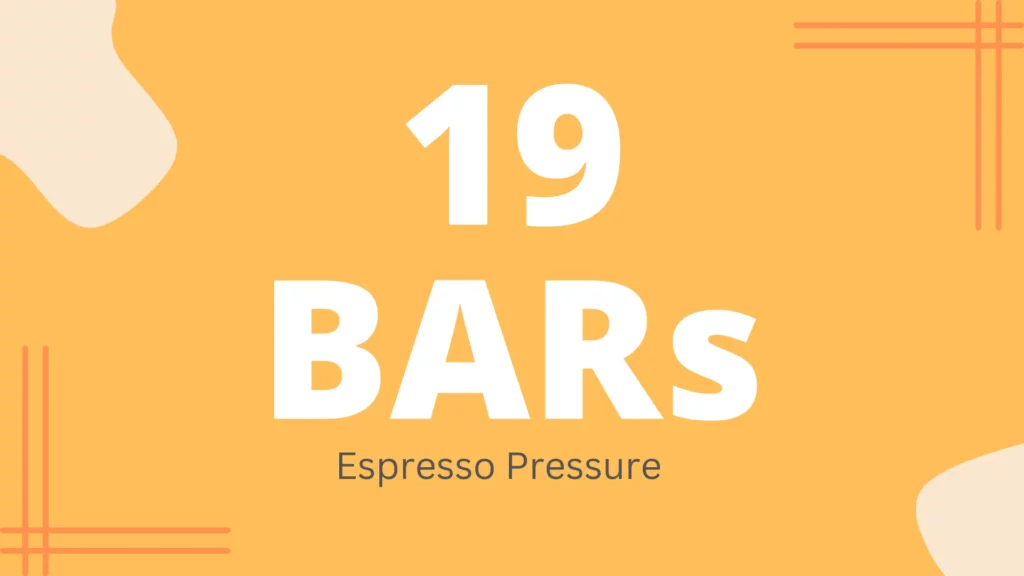
The espresso maker applies a high pressure of 19 bars of hot water under pressure through the ground coffee. Compared to conventional brewing techniques, this rapidly pushes water over coffee grounds to extract more flavor from the beans.
The result is a thick, concentrated beverage with a strong flavor and aroma. But in most cases, the flavor and aroma may feel bitter and burnt.
Some people may find that it tastes better than traditional brewing methods but others may find it to be too strong or bitter. However, if you want an intense cup of coffee, this is what you need.
Are 19 Bars Of Pressure Good For Espresso?
It can be, in some cases. Also, it won’t be, in many cases. It is not the best option for everyone. If you’re just starting out, I recommend experimenting with different settings to see what produces the best results for you.
When the coffee grounds are supposed to be extracted at a pressure level of 19 bars, you can feel how much pressure it is going to produce. And this high pressure will generally make the coffee totally different than regular 9-bar coffee. It will taste and smell like burnt out. This is not a preferable choice for most people.
What Does 20 Bar Espresso Mean?
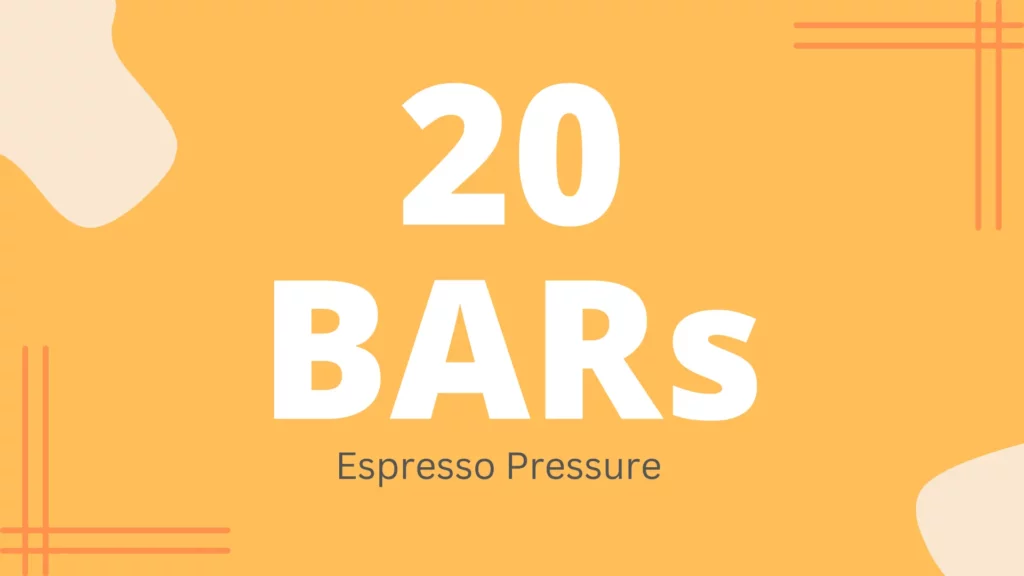
In this case, the pressure of the espresso machine is too high. It is 20 times higher than the regular atmospheric pressure on earth.
This is because the maximum pressure is about 20 bars of pressure, and so too much pressure will taste like completely different than any other coffee. It will extract more flavor and fragrance from the coffee ground. There is a maximum chance that at this pressure level, espresso will definitely taste bitter.
Are 20 Bars Of Pressure Good For Espresso?
As you are aware, changing the water’s pressure can result in a variety of flavors. The bitterness of espresso increases with increasing pressure. For that reason, if you don’t want a bitter taste of your espresso, I would say 20 bars of pressure is not good for espresso.
When you use 20 bars of pressure, however, it can cause a problem, it can damage the espresso. 20 bars of pressure is too much for espresso because it pushes too hard on the grounds. This can lead to over-extraction, which results in bitter notes in your beverage.
It’s hard to maintain consistency when you’re using more pressure than normal. When you start with more pressure, you might have trouble controlling how much hot water you’re using in your extraction process.
19 Bar Vs 15 Bar Espresso Pressure
It would be easy to differentiate the versus battle between 19-bar and 15-bar espresso. There is no huge difference between them if you understand what do BARs mean on espresso machines.
The main difference between 19 Bar and 15 Bar For Espresso is the amount of pressure used to extract the water from ground coffee beans. Both espresso machines use high pressure, but the amount of pressure used to extract the water from ground coffee beans differs between a 19 Bar machine and a 15 Bar machine.
The amount of pressure used to extract the water from ground coffee beans is what differentiates 19 Bar Espresso machines from 15 Bar Espresso machines. A 19 Bar machine uses a higher level of pressure than a 15 Bar machine to extract the water from ground coffee beans, which allows for more flavor extraction and makes for a better-tasting espresso.
When you’re making a 19 Bar, you’ll be able to make a much stronger shot of espresso. This means that it will be a stronger drink that can be enjoyed by those who want something stronger than their normal cup of coffee.
Another difference is that a 19 bar pressure produces a thicker crema, while a 15 bar pressure produces a thinner crema. The thicker crema is preferred by many coffee enthusiasts because it gives the coffee a more robust flavor. The thinner crema creates a smoother taste, but it does not have as much of an impact on the overall taste of the coffee.
9 Bar Vs 15 Bar Espresso Pressure
During the early ages of espresso invention, it was observed that anything beyond 9 bars of pressure resulted in a too-strong and thick espresso. Additionally, anything less than 9 bars made the espresso weaker. As a result, the majority of coffee makers in use today are espresso machines with 9 bars.
Although most people consider 9 bars as the sweet spot for espresso. you may think why there are other bars like 15 bars on different semi-automatic machines. You probably can think that as the bar number is high, these machines may produce better-tasting coffee.
In reality, this is not true. For better, smooth, and rich espresso, 9 bar is going to defeat the 15-bar espresso. Because most people like to have a drink that doesn’t taste bitter and burned.
Typically, these machines claim to start off with 15 bars of pressure. But by the time it reaches the group head, the pressure decreases significantly. So, by the time your espresso shot is pulled, you will have brewed at 9 bars.
15 Bar Vs 20 Bar Espresso Pressure
The 15 Bar and 20 Bar espresso machines are similar in many ways. They both have pressure gauges and buttons that can be used to control the brewing process. But they have some different settings.
The 15-bar machine has a lower pressure setting than the 20 bar machine, which allows for a weaker brew. 20 bar espresso has a higher caffeine content than 15 bar espresso.
15 bar espresso produces less foam than 20 bar espresso and has a less strong, bitter taste than 20 bar. Which means there is a slight acidic aftertaste when drinking 20 Bar Espresso.
This is because 20 bar pressure is more powerful than 15 bar pressure. It will help you get more flavor out of your coffee and make it taste better than ever before!
The main reason why 15 bar espresso machines are better than 20 bar ones is because they can make the coffee drinker feel more relaxed while drinking it. The reason why some people prefer this type of espresso machine is because they want their coffee to taste less bitter and more smooth and creamy.
The Higher The Pressure, The Better Coffee?
For those who don’t know what do BARs mean on espresso machines, may have a misconception about higher bars. Some people think that a higher pressure would make a good tasting espresso. This is not accurate in most cases. I am going to make a case for why a higher pressure method is not always better.
First off, the amount of pressure applied to an espresso machine will affect its ability to extract flavor from the beans. Also, it affects the production of a clean-tasting beverage. Higher pressures can lead to over-extraction, which can leave your coffee tasting bitter and burnt.
In addition, higher pressures cause more water to be lost through evaporation when brewing espresso. This “loss” of water reduces the amount of coffee available to extract flavors from your beans. So if you’re looking for a lighter roast or less-extracted flavor, you may want to stick with lower pressures.
Finally, higher pressures can lead to burrs in some machines’ brewing baskets. It can damage delicate parts like valves and seals.
So, it is important to know that higher pressure is not a good idea always. See your machine’s capability and your choice of taste. Then decide whether you want to have a shot with higher pressure or with normal pressure.
What Is The Ideal Pressure For Espresso?
If you want a straightforward answer to this question, then I would say 9 bar is the ideal pressure for espresso. Not just me, most of the espresso enthusiasts prefer 9 bars. This is the point at which the water reaches its saturation point for most people.
Let’s break the whole thing down. The ideal pressure for espresso is 9 bar because this is the pressure that you will get when your espresso machine has been calibrated to your own specific brewing method. Your brewing method could be a manual brewing method or a semi-automatic method, and it will be different from person to person.
So, if you want to know what the ideal pressure for espresso is, don’t just look at how many bars of pressure it says on the machine. Instead, look at how much pressure you think you should be using to make an espresso with your particular brew method.
Lower than 9 bar, to most people, feels a little watery and doesn’t taste so good. Compared with 5 or 7 bars, you will notice the espresso being weak. Because at 5 or 7 bar of pressure, the extraction process can not do its job properly and some caffeine does not get extracted at this level of pressure.
Even at 11 or 15 bar, the pressure gets too high and they extract the ground coffee too much. What is the end result here? Your coffee will be too strong. It will taste bitter and a little acidic. Also, your espresso may feel burned out.
That’s why I consider 9 bars as the ideal pressure point for espresso. Unless you like to taste a too-strong or too-weak espresso, then 9 bars is the perfect pressure for you too.
How Many Bars Of Pressure Should An Espresso Machine Have?
There is a range of pressure that an espresso machine should have. But those machines cost a lot more than those that are made in mass production. The average espresso machine that is made in mass production has about 9-10 bars of pressure.
There is no real answer to this. It is because there is not any specific way to make espresso. There are many variables that affect the quality and taste of your espresso, such as the water temperature, grind size, and amount of coffee. Also, good-quality espresso machines can make the job easier.
The water temperature is the most important factor when you are making espresso. The temperature of the water affects the flavor of the espresso. Whether you are using a 9-bar or 15-bar espresso machine, if you don’t be careful about other factors, your espresso shot won’t be better.
Although there is no set standard of how many bars of pressure an espresso machine should have, generally speaking, 7 to 11 bars of pressure is a good point for espresso machines. And remember, it also varies on personal preferences.
Pro Tips:
- Know what pressure your machine is capable to produce.
- Use finely ground coffee.
- Determine the bar pressure before brewing.
- Be careful not to over-extract the coffee beans.
- Practice to get a good understanding of your machine.
Juliet’s Observation
Hopefully by now, you have a better understanding of what do BARs mean on espresso machines and how they determine the strength of espresso. Also, I have described to you the different bars and their functionality.
If you already understand the basic of the bar pressure methods and how they work, next time, you will get better-tasting espresso than you want them to be.
- How To Clean Calphalon Temp IQ Espresso Coffee Machine? - July 4, 2023
- How To Use Continental Electric Espresso Machine? 9 Easy-peasy Steps! - June 17, 2023
- What Is A Lever Espresso Machine? A Complete Overview! - June 17, 2023

